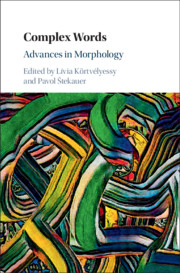Book contents
- Complex Words
- Complex Words
- Copyright page
- Dedication
- Contents
- Contributors
- Introduction: Advances in Morphology
- Part I Lexico-Semantic Aspects of Complex Words
- Part II Structure of Complex Words
- 7 Estonian Case Inflection Made Simple
- 8 Uninflectedness
- 9 Complex Exponents
- 10 Derivational Patterns in Proto-Basque Word Structure
- 11 The Complexity of Greek Verbal Morphology
- 12 Affixoids
- Part III Corpus-Based Case Studies
- Index
- References
11 - The Complexity of Greek Verbal Morphology
The Case of Prefixed Verbs
from Part II - Structure of Complex Words
Published online by Cambridge University Press: 18 September 2020
- Complex Words
- Complex Words
- Copyright page
- Dedication
- Contents
- Contributors
- Introduction: Advances in Morphology
- Part I Lexico-Semantic Aspects of Complex Words
- Part II Structure of Complex Words
- 7 Estonian Case Inflection Made Simple
- 8 Uninflectedness
- 9 Complex Exponents
- 10 Derivational Patterns in Proto-Basque Word Structure
- 11 The Complexity of Greek Verbal Morphology
- 12 Affixoids
- Part III Corpus-Based Case Studies
- Index
- References
Summary
This paper examines the distribution of non-active Voice morphology on intransitive variants of prefixed verbs in Greek. It is shown that such verbs bear internal prefixes and are causative and transitive. Their intransitive variants bear non-active morphology obligatorily undergoing a process of detransitivization. It is further shown that this holds also for reflexive marking in Romance (Catalan and French). This is due to a reanalysis of the particle system of the languages under discussion, according to which internal prefixes have been reanalyzed and cannot be morphophonologically separated from the verbal stem. This suggests that all three languages changed from a more lexeme-like type of prefix system (Bauer 2003) to a system where prefixes are void of spatial semantic content and seem to function as transitivity markers.
Keywords
- Type
- Chapter
- Information
- Complex WordsAdvances in Morphology, pp. 192 - 216Publisher: Cambridge University PressPrint publication year: 2020

